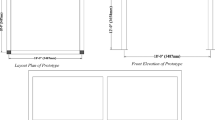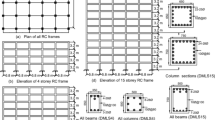Abstract
The study aims to explore the application of concrete-filled steel tube (CFST) columns as a more resilient and sustainable alternative to vulnerable reinforced concrete (RC) columns in rigid-frame bridges prone to significant damage during strong earthquakes with large vertical ground motion intensities. A series of multi-axis hybrid simulations on a rigid-frame bridge structure are conducted, with circular and square CFST column cross-sections. The structure is subjected to combined horizontal and vertical ground motions using the state-of-the-art hybrid testing facility, the multi-axis substructures testing (MAST) system at Swinburne University of Technology. The test results of the CFST columns are then compared with those of a previous hybrid testing study on circular RC columns used in the construction of the same bridge structure. The study utilizes the classic performance-based earthquake engineering (PBEE) framework to compare the observed damage states and quantify the repair sustainability metrics, including repair cost (economic), repair downtime (social), and repair carbon emissions (environmental). The research findings confirm the superior seismic performance of CFST columns and highlight their potential in enhancing the resilience and sustainability of critical and post-disaster bridges that are susceptible to strong vertical ground motions.
Access this chapter
Tax calculation will be finalised at checkout
Purchases are for personal use only
Similar content being viewed by others
References
Hashemi MJ, Al-Attraqchi AY, Kalfat R, Al-Mahaidi R (2019) Linking seismic resilience into sustainability assessment of limited-ductility RC buildings. Eng Struct 188:121–136
Hashemi J, Tsang HH, Al-Ogaidi Y, Wilson J, Al-Mahaidi R (2017) Collapse assessment of RC building columns through multi-axis hybrid simulation. ACI Struct J 114:437–449. https://doi.org/10.14359/51689438
Hashemi MJ, Al-Ogaidi Y, Al-Mahaidi R, Kalfat R, Tsang HH, Wilson JL (2017) Application of hybrid simulation for collapse assessment of post-earthquake CFRP-repaired RC columns. J Struct Eng 143(1):04016149
Gunay S, Mosalam KM (2013) PEER performance-based earthquake engineering methodology Revisited. J Earthq Eng 17(6):829–858
Kim SJ, Holub CJ, Elnashai AS (2011) Experimental investigation of the behavior of RC bridge piers subjected to horizontal and vertical earthquake motion. Eng Struct 33(7):2221–2235
Mast R, et al. (1996) Seismic Design of Bridges. Design Example No. 4: Three-Span Continuous CIP Concrete Bridge. Federal Highway Administration
AASHTO (1995) Standard specifications for highway bridges, division I-A: seismic design. 15th ed. Washington, DC: American Association of State Highway and Transportation Officials
Al-Attraqchi AY, Hashemi MJ, Al-Mahaidi R (2020) Hybrid simulation of bridges constructed with concrete-filled steel tube columns subjected to horizontal and vertical ground motions. Bull Earthq Eng 18(9):4453–4480. https://doi.org/10.1007/s10518-020-00871-7
Hashemi MJ, Al-Mahaidi R, Kalfat R, Burnett G (2015) Development and validation of multi-axis substructure testing system for full-scale experiments. Aust J Struct Eng 16(4):302–315
AlMahaidi R, Hashemi J, Kalfat R, Burnett G, Wilson J (2018) Multi-Axis Substructure Testing System for Hybrid Simulation. Multi-Axis Substructure Testing System for Hybrid Simulation, p 1–81
Del Carpio RM, Hashemi MJ, Mosqueda G (2017) Evaluation of integration methods for hybrid simulation of complex structural systems through collapse. Earthq Eng Eng Vib 16(4):745–759
Hashemi MJ, Mosqueda G, Lignos DG, Medina RA, Miranda E (2016) Assessment of numerical and experimental errors in hybrid simulation of framed structural systems through collapse. J Earthq Eng 20(6):885–909
Hashemi MJ, Mosqueda G (2014) Innovative substructuring technique for hybrid simulation of multistory buildings through collapse. Earthq Eng Struct Dynam 43(14):2059–2074
Hashemi MJ, Masroor A, Mosqueda G (2014) Implementation of online model updating in hybrid simulation. Earthq Eng Struct Dynam 43(3):395–412
McKenna F (2011) OpenSees: a framework for earthquake engineering simulation. Comput Sci Eng 13(4):58–66
FEMA P (2009) Quantification of Building Seismic Performance Factors. Report No: FEMA-695. FEMA P695. Washington: Federal Emergency Management Agency (FEMA). 287 (A-16)
Al-Attraqchi AY, Hashemi MJ, Al-Mahaidi R (2022) Loss assessment of rigid-frame bridges under horizontal and vertical ground motions. Structures 35:243–259
Mackie KR, Wong J-M, Stojadinovicʹ B (2008) Integrated probabilistic performance-based evaluation of benchmark reinforced concrete bridges. Pacific Earthquake Engineering Research Center
Han L-H, Lin X-K, Wang YC (2006) Cyclic performance of repaired concrete-filled steel tubular columns after exposure to fire. Thin-walled struct 44(10):1063–1076
Bumstead J, Korat J, Stephens M (2019) Repair Strategies for Earthquake-Damaged CFST Bridge Columns. In: Structures Congress 2019American Society of Civil Engineers.
Author information
Authors and Affiliations
Corresponding author
Editor information
Editors and Affiliations
Rights and permissions
Copyright information
© 2023 The Author(s), under exclusive license to Springer Nature Switzerland AG
About this paper
Cite this paper
Hashemi, J., Al-Attraqchi, A., Al-Mahaidi, R. (2023). Comparative Assessment of RC and CFST Columns in Rigid-Frame Bridges Subjected to Horizontal and Vertical Ground Motions. In: Ilki, A., Çavunt, D., Çavunt, Y.S. (eds) Building for the Future: Durable, Sustainable, Resilient. fib Symposium 2023. Lecture Notes in Civil Engineering, vol 349. Springer, Cham. https://doi.org/10.1007/978-3-031-32519-9_155
Download citation
DOI: https://doi.org/10.1007/978-3-031-32519-9_155
Published:
Publisher Name: Springer, Cham
Print ISBN: 978-3-031-32518-2
Online ISBN: 978-3-031-32519-9
eBook Packages: EngineeringEngineering (R0)




